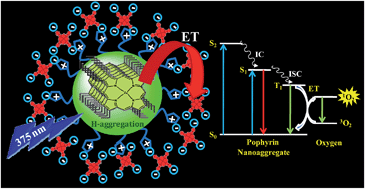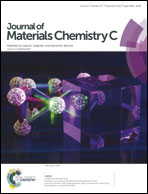Photophysical properties of ionic liquid-assisted porphyrin nanoaggregate–nickel phthalocyanine conjugates and singlet oxygen generation†
Abstract
In this report, we demonstrate the formation of ionic liquid (IL)-assisted zinc octaethylporphyrin (ZnOEP) nanoaggregates which is confirmed by field emission scanning electron microscopy (FE-SEM) and atomic force microscopy (AFM) studies. A large red shifted emission of ZnOEP nanoaggregates in comparison to ZnOEP in DCM confirmed the H aggregation which is due to intermolecular porphyrin–porphyrin (such as π–π/hydrophobic) interactions. The steady state and time resolved spectroscopic studies unambiguously confirm the H-aggregation formation of porphyrin molecules during nanoaggregate formation. The significant quenching of the fluorescence spectrum and the shortening of decay time of porphyrin nanoaggregates imply an efficient (89%) energy transfer from porphyrin nanoaggregates to phthalocyanine. Furthermore, the emission band observed at 1270 nm unambiguously confirms the singlet oxygen (1O2) generation from ZnOEP nanoaggregates which opens up further prospects in designing new IL-assisted porphyrin nanoaggregates for their application in photodynamic therapy.

- This article is part of the themed collection: 2014 Journal of Materials Chemistry C Hot Articles

 Please wait while we load your content...
Please wait while we load your content...